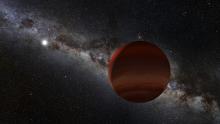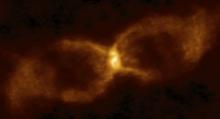Listen to today's episode of StarDate on the web the same day it airs in high-quality streaming audio without any extra ads or announcements. Choose a $8 one-month pass, or listen every day for a year for just $30.
You are here
On the Border
A recently discovered planet in a star system 130 light-years away is on the border — the dividing line between a planet and a brown dwarf.
HD 206893c is the third member of its system. The main member is a star that’s bigger and heavier than the Sun. It has a distant companion known as a brown dwarf — an object that’s more massive than a planet but not massive enough to shine as a star.
The planet was hinted at by Gaia, a space telescope that’s observing more than a billion stars. A big telescope on the ground provided more details on the system, and even snapped the planet’s picture.
HD 206893c is a little bigger than Jupiter, the giant of our own solar system — and almost 13 times as heavy. That puts it on a border line. Anything less massive is definitely a planet, while anything heavier is most likely a brown dwarf.
Yet the planet is much brighter than most big planets. That suggests that it’s “fusing” a form of hydrogen in its core — something that usually happens in light-weight brown dwarfs. So studying this odd object may help scientists nail down the definitions of both planets and brown dwarfs — and the dividing line between them.
HD 206893 is low in the southeast at nightfall, and is bright enough to see through binoculars. It’s in the constellation Capricornus, not far to the upper right of the planet Saturn, which looks like a bright golden star.
Script by Damond Benningfield






